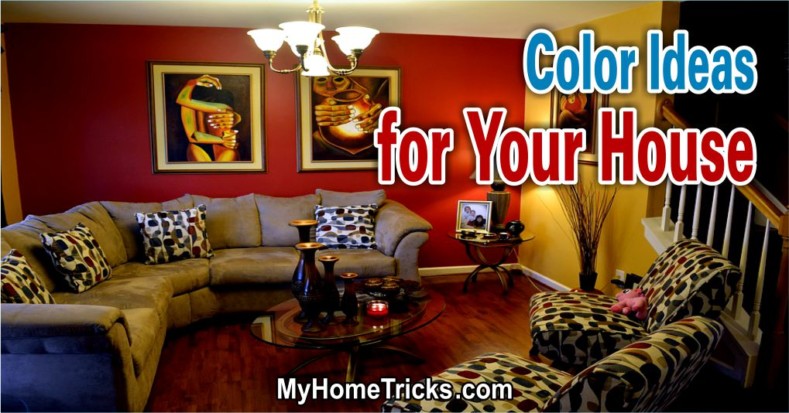Colors have certain properties that can evoke particular feelings in a room. You may choose a color scheme simply to change the character of your room or to create a certain atmosphere by means of that color’s characteristics.
Transforming Rooms With Color
When starting the decoration of a room from scratch, examine the function of the room and who is going to be using it.
Catering for occupants: If a room is for common use, cater for general taste rather than individual needs. Even a personal room such as a bedroom will require very different decor, in both practical and aesthetic terms, depending on whom it is designed for.
Considering function: Select your colors according to whether a room will be used for rest and relaxation, for fun and recreation, or for work
Playing with greens In a bedroom intended for use by a child, bear in mind that its functions will include both rest and recreation. You will have the scope to use different colors to enliven the atmosphere and add interest to the room’s occupants.
Relaxing in warm pinks: You can transform a room almost completely just by changing its color. Use a uniform color scheme in an adult’s bedroom, for example, to ensure that features do not leap out and to maintain a restful atmosphere.
Subtle Or Bold
Subtlety and boldness are generally equated to using bright, vibrant colors than paler hues, with conservatism and daring, respectively, since brighter colors tend to have a greater initial. This is because it is considered a far more risky impact and effect than more subtle variations.
Mixing & Matching
Staying Pale: limiting the difference: Maintain a narrow margin of difference between the colors in a scheme to produce a calming feel. The paler these colors, the more subtle the scheme and the greater the effect will be.
Being Bold
Going to extremes: Use bold, vibrant colors to give a dynamic feel to a room. A bright, cheerful atmosphere can also be relaxing, and subtle lighting can create a feeling of sumptuousness and calm.
Highlighting features: Choose subtle colors for walls, woodwork, and floors to allow you to use bold colors and patterns for soft furnishings in order to draw attention to these items.
Framing walls: Use bold colors on woodwork and more subtle variations on walls, which will have the effect of “framing” the walls. Enhance this effect with a bold ceiling color. The walls will then set off pictures well.
Using white Include white, which is perhaps the most subtle color of all, to show off other colors successfully.
Warm or Cool
Colors have definite warming or cooling properties that can be used to great effect in all areas of the home. Combining several warm or cool colors, or using both warm and cool together, can produce a range of different atmospheres and moods to suit your needs.
Warming Up & Cooling Down
Bringing in warmth: The warming effect of these colors is enhanced by the fact that they appear to bring the walls nearer and reduce space in the room. Choose colors like these for coziness.
Creating space: Typical cool colors tend to have a receding effect on walls, which gives a greater feeling of space in a room. Use this to create an open, airy atmosphere, as well as create a cool effect.
Adjusting Effects
• Emanating warmth: Oranges, reds, pinks, and warm yellows create a cozy atmosphere. Choose warm colors such as these for a room that receives little or no direct sunlight.
• Freshening up: Select a cool, refreshing color scheme with blues and greens for areas such as narrow corridors that need opening up, or for sunny rooms that may overheat.
• Varying intensity: The extent to which color has a warming or cooling influence depends on its intensity and its shade. Use dark colors carefully, since these tend to have the most marked effect.
Nurturing warmth and comfort: Create a feeling of coziness and reassurance by basing an entire color scheme on warm hues. In this room, the rich, red wall color is accentuated by similar tones in the furnishings. Even the orange undertones on the natural wooden floor contribute to the room’s warm and welcoming atmosphere.
Keeping Cool
Adopting a fresh approach: Choose a color scheme such as the all-over blues in this kitchen to provide a fresh, revitalizing feeling. In a room that is used mostly in the mornings, and which receives plenty of natural sunlight, there is probably no need to introduce warm colors to enliven the atmosphere.
Light or Dark
The use of a light or dark color does, of course, create a correspondingly light or dark atmosphere in a room. However, different shades of the same color also have additional characteristics and can be used individually to dramatic effect in the overall, color scheme.
Making Light Work
Enlarging a room: Light colors on large surfaces create a feeling of space. Use them to make a small room seem larger, or on selective surfaces such as ceilings to give an impression of greater height.
Staying in the Dark
Enclosing a room: Dark colors tend to draw surfaces toward the viewer, therefore reducing the feeling of space. Use them to “lower” high ceilings or add coziness and intimacy to a large room.
Modifying Choices
• Playing safe: Use light, pastel shades if you are unsure of your decorating skills. Even if you are inexperienced, you should be able to mix and match them with relative ease.
• Covering blemishes: Dark colors, especially used on woodwork, will camouflage unevenness or blemishes better than lighter shades. Use dark colors to maximize the quality of the finish.
• Extending life: Dark colors are better at concealing dirt and coping with general wear and tear. Choose darker shades, therefore, to prolong the life of a decorative scheme.
Using Pale Colors Effectively
Keeping a room light and airy: Use pale colors to produce a very light and airy feel, as in this living room, where it is further enhanced by the use of both natural and artificial light. Maintain the continuity of these creamy tones throughout all the decorations in the room to achieve a unified, harmonious atmosphere.
Using Dark Colors Effectively
Creating warmth and coziness: Combine relatively pale colors on the walls with contrasting darker shades for the rest of the decoration in a room. This will produce a slightly enclosed, yet at the same time very comfortable, impression. Create an extra touch of opulence by making the dark colors rich and warm.
Blending and Toning
Blending and toning can often be the most difficult concept to grasp when choosing colors. You need to decide which features should be accentuated and which should be blended in with the general decor in order to produce a sympathetic color scheme.
Maintaining a Blend
• Setting the tone: Choose colors to suit a room’s function and the impact you wish to make. Use subtle tones in areas of rest and more intense hues in activity rooms.
• Creating mood: Select a shade that is appropriate for a room’s mood. Slightly tinting a color one way or another can make all the difference.
• Reducing impact: Use colors to make unsightly features less noticeable. Paint a radiator the same color as the walls, for example.
Blending Together
Choose the main wall color so that it blends in with the color of another significant feature in the room. In the example shown here, the natural wood finish of the fireplace and the furniture tones effectively with the pale ochre walls and smaller items such as paintings and ornaments to create a harmonious and relaxed feel in the room.
Extending the same colors and designs from one surface to another is a further way of using color to balance a decorative scheme.
This link can be made between all surfaces in a room including the flooring and furnishings, as well as the smaller decorative details.
Locating Color in Less Obvious Places
Maintaining a theme between features: Link features or rooms together by sharing a theme, for example by extending a pattern from one decorative feature to another. Here, the bands of tricolored squares running above the kitchen work surface and above the baseboard have also been applied to the painted frame. Use constituent colors separately on other selected surfaces to echo and maintain the theme between features or rooms.
Following Guidelines
• Including ornaments: As well as using similar colors on all the major surfaces in a room, extend your color scheme to your ornaments and collections on display to match the components of your decorative plan further.
• Incorporating textures: The textured aspect of a decorative plan can also be linked in with a color scheme. For example, reflect the different shades and tones produced by natural floorings, such as seagrass, wicker baskets, and other accessories in the room.
• Scheming simply: The best effects are often created by means of a few simple color statements. Avoid including too many colors, since this tends to produce a very cluttered feel that will be too busy for most rooms.







